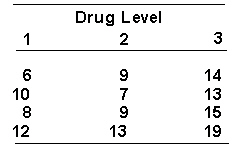Multiple Choice
An investigator conducts an experiment involving the effects of three levels of a drug on memory. Subjects are randomly assigned to one of three conditions. A different drug level is administered in each condition. Memory is measured 10 minutes after each subject receives the drug. The following scores are recorded. The higher the score, the better the memory.  Using a = 0.05, what do you conclude?
Using a = 0.05, what do you conclude?
A) reject H 0 ; the drug has the same effect on memory at all levels
B) reject H 0 ; the drug does not have the same effect on memory at all levels
C) retain H 0 ; we cannot conclude that the drug affects memory
D) accept H 0 ; the drug has no effect on memory
Correct Answer:

Verified
Correct Answer:
Verified
Q5: The HSD test _.<br>A) is used for
Q6: A pharmacologist is interested in determining whether
Q7: Define estimated omega squared ( <img src="https://d2lvgg3v3hfg70.cloudfront.net/TBX9373/.jpg"
Q8: F obt = ( ΣS<sub> between</sub> /df
Q9: The analysis of variance technique analyzes the
Q11: If F <sub>obt</sub> F <sub>crit</sub>, we reject
Q12: Define eta squared ( <img src="https://d2lvgg3v3hfg70.cloudfront.net/TBX9373/.jpg" alt="Define
Q13: When doing planned comparisons, _.<br>A) there is
Q14: The df used in the Scheffé test
Q15: The F test is not used when